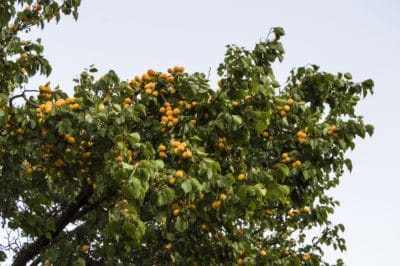Planting an Apricot Tree
Select a variety of apricot suited for your climate zone, and purchase a bare-root tree just before planting. Keep the roots wrapped in a moist burlap bag, or place soil over them until planting time to prevent them from drying out.
Dig a hole in a sunny, well-drained location, making the hole about two times as large as the root ball, and add compost or peat moss to the native soil to improve drainage.
Place the tree in the hole, being sure that the root graft line is about 2 inches (5cm) above the top of the soil. Then make a rim of soil around the tree about 2 feet (.6 meters) away from the trunk to hold water, and water the tree immediately after planting.
At planting time, prune the tree by removing branches which are growing upward and preserving the best three of four branches growing outward at a 45 degree angle.
Watering and Fertilizing Apricot Trees
Apricot trees do not need water during the winter or late fall, but water them approximately every two weeks from late spring throughout the summer, unless it rains.
Apply water with a soaker hose or by letting a hose trickle slowly around the tree, so water sinks deeply into the soil. As a general rule, give each tree about 10 gallons (39 liters) of water for every 1 inch (2.5cm) of diameter size of the trunk at knee-level height.
To conserve water, apply a layer of mulch around the base of the tree, keeping it 6 inches (15cm) back from the trunk.
Fertilize the tree in early spring just before buds bloom by applying a balanced fertilizer. Each tree needs about 0.1 lbs. (45 grams) of nitrogen each season, so check the nitrogen percentage of the fertilizer you choose to determine how much to apply.
Organic fertilizers for apricot trees include:
- Composted chicken or turkey manure
- Blood meal
- Cottonseed meal
- Feather meal
- Soy bean meal
Thinning and Harvesting Apricots
Apricots bloom in late spring, and fruit is ready for picking 100 to 120 days later for most varieties. When fruits are about 1/2 to 1 inch (1.25 to 2.5cm) in diameter, thin them, leaving a space of 2 to 4 inches (5 to 10cm) between fruits.
Harvest your apricots in July or August when they turn a dark yellow-orange color and are slightly soft when squeezed.
